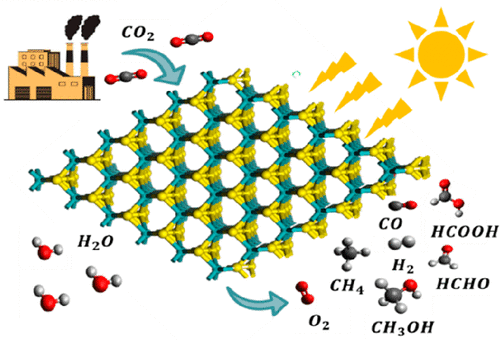当前位置:
X-MOL 学术
›
ACS Appl. Nano Mater.
›
论文详情
Our official English website, www.x-mol.net, welcomes your
feedback! (Note: you will need to create a separate account there.)
MoS2–Nanosheets-Based Catalysts for Photocatalytic CO2 Reduction: A Review
ACS Applied Nano Materials ( IF 5.3 ) Pub Date : 2021-08-24 , DOI: 10.1021/acsanm.1c00990 Shreya Singh 1 , Arindam Modak 1 , Kamal Kishore Pant 1 , Apurba Sinhamahapatra 2 , Pratim Biswas 3
ACS Applied Nano Materials ( IF 5.3 ) Pub Date : 2021-08-24 , DOI: 10.1021/acsanm.1c00990 Shreya Singh 1 , Arindam Modak 1 , Kamal Kishore Pant 1 , Apurba Sinhamahapatra 2 , Pratim Biswas 3
Affiliation

|
Artificial photosynthesis is a clean and sustainable technique to mitigate the increasing greenhouse CO2 concentrations via simultaneous energy production to meet the ever-growing energy demands. A light-assisted CO2 conversion primarily depends on catalytic materials for the prompt adsorption and conversion of CO2 to solar fuels under ambient conditions. An enormous effort shows the development of new photocatalytic materials, and two-dimensional metal dichalcogenides are promising due to their unique surface structure and their low band gap potentials that allow visible-light photocatalysis. Additionally, their tunable optical characteristics and high stability under a continuous illumination are strongly applied in making advanced photochemical devices in several front-line areas. Among metal dichalcogenides, MoS2 is well-explored in hydrogen evolution, pollutants degradation, and the photoreduction of CO2 to valuable fuels (CH4, CO, CH3OH, HCOOH). Considering the unique advantages of MoS2 nanomaterials in a photocatalytic CO2 reduction, yet a single review is lacking that combines all the aspects of CO2 reduction. This review provides a thorough understanding of the MoS2-based nanomaterials for photocatalytic CO2 reduction reactions (PCO2RR) and inspects the current progress in this domain with an initial description centered on insights of the thermodynamics of the photoassisted conversion process. The second portion acquaints the reader with advances in the MoS2-based nanomaterials in their fabrication and associated techniques for tuning the suitable properties by tailoring approaches, particularly doping, heterostructure formation, and self-modifications adopted to enhance the functionality toward proliferating the conversion and selectivity for PCO2RR. Finally, from the context of both theoretical and experimental investigations, we discuss future opportunities and potential strategies to elevate the structural, optical, and carrier dynamic properties to boost the quantum efficiency of MoS2. This contribution may create an avenue to implement cost-effective novel chalcogenides for solving environmental problems via light-meditated sustainable approach.
中文翻译:

用于光催化 CO2 还原的基于 MoS2-纳米片的催化剂:综述
人工光合作用是一种清洁且可持续的技术,可通过同步生产能源来满足不断增长的能源需求,从而缓解不断增加的温室 CO 2浓度。光辅助 CO 2转化主要依赖于催化材料对 CO 2的快速吸附和转化环境条件下的太阳能燃料。巨大的努力表明新光催化材料的发展,二维金属二硫属化物由于其独特的表面结构和允许可见光光催化的低带隙电位而很有前途。此外,它们在连续照明下的可调光学特性和高稳定性在几个前沿领域被广泛应用于制造先进的光化学设备。在金属二硫属化物中,MoS 2在析氢、污染物降解和将 CO 2光还原为有价值的燃料(CH 4、CO、CH 3 OH、HCOOH)方面得到了很好的探索。考虑到 MoS 2的独特优势光催化 CO 2还原中的纳米材料,但缺乏结合 CO 2还原所有方面的单一综述。该综述提供了对用于光催化 CO 2还原反应 (PCO 2 RR) 的基于MoS 2的纳米材料的全面了解,并通过以对光辅助转化过程的热力学见解为中心的初步描述来检查该领域的当前进展。第二部分让读者了解 MoS 2 的进展基于纳米材料的制造和相关技术,通过定制方法,特别是掺杂、异质结构形成和自修饰来调整合适的性能,以增强功能,以提高 PCO 2 RR的转化率和选择性。最后,从理论和实验研究的背景下,我们讨论了提升结构、光学和载流子动力学特性以提高 MoS 2的量子效率的未来机会和潜在策略。这一贡献可能为实施具有成本效益的新型硫属元素化物开辟一条途径,通过光冥想的可持续方法解决环境问题。
更新日期:2021-09-24
中文翻译:

用于光催化 CO2 还原的基于 MoS2-纳米片的催化剂:综述
人工光合作用是一种清洁且可持续的技术,可通过同步生产能源来满足不断增长的能源需求,从而缓解不断增加的温室 CO 2浓度。光辅助 CO 2转化主要依赖于催化材料对 CO 2的快速吸附和转化环境条件下的太阳能燃料。巨大的努力表明新光催化材料的发展,二维金属二硫属化物由于其独特的表面结构和允许可见光光催化的低带隙电位而很有前途。此外,它们在连续照明下的可调光学特性和高稳定性在几个前沿领域被广泛应用于制造先进的光化学设备。在金属二硫属化物中,MoS 2在析氢、污染物降解和将 CO 2光还原为有价值的燃料(CH 4、CO、CH 3 OH、HCOOH)方面得到了很好的探索。考虑到 MoS 2的独特优势光催化 CO 2还原中的纳米材料,但缺乏结合 CO 2还原所有方面的单一综述。该综述提供了对用于光催化 CO 2还原反应 (PCO 2 RR) 的基于MoS 2的纳米材料的全面了解,并通过以对光辅助转化过程的热力学见解为中心的初步描述来检查该领域的当前进展。第二部分让读者了解 MoS 2 的进展基于纳米材料的制造和相关技术,通过定制方法,特别是掺杂、异质结构形成和自修饰来调整合适的性能,以增强功能,以提高 PCO 2 RR的转化率和选择性。最后,从理论和实验研究的背景下,我们讨论了提升结构、光学和载流子动力学特性以提高 MoS 2的量子效率的未来机会和潜在策略。这一贡献可能为实施具有成本效益的新型硫属元素化物开辟一条途径,通过光冥想的可持续方法解决环境问题。











































 京公网安备 11010802027423号
京公网安备 11010802027423号